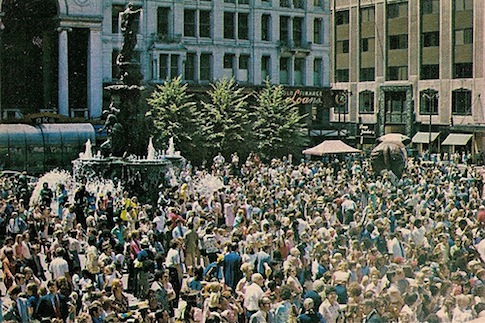Matt Novak over at the Smithsonian blog, Paleofuture, recently posted a really great article on a radical concept for rapid transit that once swept over the world: Moving Sidewalks.
(I'm referring to those proposals for long distances, because as we all know, they already exist and work well in smaller-scale versions today.) Anyway, his article is a great source for the definition and history of the Moving Sidewalk as a mass transit system, so without regurgitating that info, I'll just review the few items relating Cincinnati's hat in this ring.
• • • • • • • • • •
"Closer Than We Think!" illo by Arthur Radebaugh.
Possibly the first touch locally for this transit concept was in “The Roads Must Roll”, a sci-fi short written by Robert A. Heinlein (1940), about future cities built around
moving sidewalks.
In Heinlein's story, massive conveyors replaced highways and rail as the dominant form of transportation in the US, but as dependence on them grew, they were susceptible to sabotage, which forms the overriding plot (perhaps not unlike the real story of the automakers supplant of the US rail system). In his description of the landscape, he incorporates a Midwest trail which fairly resembles Ohio's scrapped 3C corridor:
Robert Heinlein imagined the United States—facing a war-strained
petroleum shortage that meant the "end of the automobile era was in
sight"—shifting to a series of massive commuter moving walkways. Of the
first "mechanized road," built between Cincinnati and Cleveland [in 1960],
Heinlein writes: "It was, as one would expect, comparatively primitive
in design, being based on the ore belt conveyors of ten years earlier.
The fastest strip moved only thirty miles per hour, and was quite
narrow, for no one had yet thought of the possibility of locating retail
trade on the strips themselves." (Source.)
And detailing it further:
...there is a massive network of parallel moving belts, the inner ones
faster. Passengers are screened from wind, and there are chairs and even
shops on the belt. In the Heinlein work the fast lane runs at 100 mph
(160 km/h)... The relative speed of two adjacent belts is
5 mph (8 km/h) (in the book the fast lane stops, and the second lane keeps running at 95 mph (152 km/h)). (Source.)
In 1953, Goodyear turned fiction into reality. Contributing to the mass transit dialogue, they offered their industrial conveyor belts as peoplemovers, which perked up local ears:
The Goodyear Tire and Rubber Company proposed a new, technologically-advanced public transit system that wasn't quite "rapid transit," but was close enough. (Source.)
From Time Magazine (1954):
Goodyear has been working on the idea as a safe, fast method of travel
in overcrowded cities. Last spring, with the Stephens-Adamson
Manufacturing Co. of Aurora, Ill., its partner in the new belt company,
Goodyear installed its first project: a $75,000 "speedwalk" to carry
New Jersey commuters 227 ft. from the Hudson & Manhattan Railroad's
Jersey City terminal up an incline to the Erie Railroad station.
Besides Manhattan, half a dozen big U.S. cities may soon be customers
for the Goodyear passenger belt. Cincinnati is considering a belt-car
system to serve 80 congested downtown blocks. So are Montreal,
Cleveland, San Francisco, Atlanta, and São Paulo, Brazil, which is
thinking of a web of conveyor-belt sidewalks. (Source.)
Popular Science (1954) continues:
Both New York City and Cincinnati are seriously considering plans for solving traffic problems with similar conveyor belts. In New York, a four-block-long system extending from Times Square to Grand Central Station has been proposed. This would take the place of overcrowded subway trains that now clatter back and forth over a so-called "shuttle" line. And in downtown Cincinnati, a two-way subway belt-conveyor loop has been proposed to uncork bottlenecks in a six-block-long and three-block-wide area. (Source.)
From the City of Cincinnati:
"The Passenger Conveyor Belt for Cincinnati" promised a "modern subway system" for the Queen City. This was an "ultra-modern transportation method" that would virtually eliminate motor and pedestrian traffic congestion, serving as the heart of the city's present public transportation system. It would even eliminate the need for most on-street parking in the main business district. (Source.)
Though, slowly, these unbuilt concepts began gathering dust as decades passed with waning local enthusiasm for this mode of transportation.
Yet, while conveyor belts for mass public transit became stale and unrealistic, there were areas of private infrastructure that handled enough bodies to float these concepts for themselves - seen throughout the world today, specifically in stadiums, theme parks, and airports - harkening back to an era of unabashed enthusiasm for grandiose ideals:
[In 1953] Goodyear suggested other uses for the Speedwalk. Modern airports could use the moving sidewalk for two-way transportation: passengers could walk while on the moving belt and increase their speed by 50 percent, or they could stand still on the belt while being carried through the airport... (Source.)
Finally, with a near palpable sense of nostalgia, the Cincinnati/Northern Kentucky Airport expansion in the 80s
& 90s - particularly the construction of Delta's hub (the massive Concourse B) - saw a spike in foot traffic and responded creatively:
A few novel ways to increase
the flow of pedestrian traffic through the sprawling structure
included the installation of the long-held dream: the Moving Sidewalk...
...the only remaining tangible vestibule to this futuristic transit concept of Cincinnati's past.
Definitions:
Wikipedia
New World Encyclopedia
Sources:
Matt Novak, Paleofuture blog / Smithsonian.com (January 11, 2012)
An idea for urban transport, cribbed from the airport.
Slate Magazine (July 6, 2010)
Time Magazine (November 15, 1954)
Popular Science Magazine (February 1954)
Further reading:
Mike Treder, Institute for Ethics and Emerging Technologies (August 9, 2009)
Cedric Benetti, Paris 2e (April 2, 2008)
Matt Novak, Paleo-Future (June 25, 2007)
James R. Berry, Mechanix Illustrated (November 1968)

















































